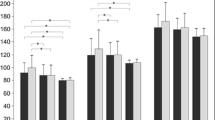Abstract
We studied W-shaped waveforms that occurred in full-field responses to pattern large-field stimulation in patients who had optic neuritis. Affected eyes showed no absolute scotomata; visual acuity was normal at the time of recording. To evaluate the contribution of macular- and paramacular-derived components to the development of the W-shaped waveforms in the patients, half-field and central full-field stimulation was used. The responses were compared with those obtained with the use of experimental scotomata in healthy subjects.
The W-shaped waveforms recorded in the patients closely resembled the responses observed in healthy subjects after the introduction of experimental scotomata. In all affected eyes, half-field stimulation showed absence of the ipsilateral P100 component or its interaction with the P135 component. Enhanced paramacular N105 and P135 components were seen over the contralateral hemisphere. Responses to central full-field stimulation were an attenuated and prolonged P100 in the majority of affected eyes.
Results of our study showed that W-shaped waveforms in response to large full-field stimulation may reflect impaired function of macular fibers. These electrophysiologic findings, however, were not always associated with evidence of a central field defect demonstrated by Friedmann perimetry.
Similar content being viewed by others
References
Hoeppner T, Lolas F. Visual evoked responses and visual symptoms in multiple sclerosis. J Neurol Neurosurg Psychiatr 1978; 41: 493–8.
Halliday AM. The value of half-field stimulation in clinical visual evoked potential testing. In Morocutti C, Rizzo PA, eds. Evoked potentials. Neurophysiological and clinical aspects. Amsterdam: Elsevier Science Publishers. 1985: 293–313.
Blumhardt LD. The abnormal pattern visual evoked response in neurology. In Halliday AM, Butler SR, Paul R, eds. A textbook of clinical neurophysiology. Chichester, NY: John Wiley & Sons. 1987: 307–42.
Carroll WM, Halliday AM, Kriss A. Improvements in the accuracy of pattern visual evoked potentials in the diagnosis of visual pathway disease. Neuro-ophthalmology 1982; 2: 237–53.
Brecelj J, Kriss A. Pattern reversal VEPs in optic neuritis: Advantages of central and peripheral half-field stimulation. Neuro-ophthalmology 1989; 9: 55–63.
Halliday AM, Barrett G, Blumhardt LD, Kriss A. The macular and paramacular subcomponents of the pattern evoked response. In Lehman D, Callaway E, eds. Human evoked potentials: applications and problems. New York: Plenum Press. 1979: 135–51.
Blumhardt LD, Barrett G, Halliday AM, Kriss A. The effect of field size on the pattern reversal visual evoked response (PRVER). Clin Vision Sci 1989; 4: 27–40.
Blumhardt LD. Visual field defects and pathological alternations in topography: factors complicating the estimation of visual evoked response ‘delay’ in multiple sclerosis. In Cracco RQ, Bodis-Wollner I, eds. Evoked potentials. New York: Alan R. Liss. 1986: 354–65.
Blumhardt LD, Barrett G, Kriss A, Halliday AM. The pattern-evoked potential in lesions of the posterior visual pathways. In Bodis-Wollner I, ed. Evoked potentials, Ann NY Acad Sci 1982; 388: 264–89.
Author information
Authors and Affiliations
Rights and permissions
About this article
Cite this article
Brecelj, J., Štrucl, M. & Hawlina, M. Central fiber contribution to W-shaped visual evoked potentials in patients with optic neuritis. Doc Ophthalmol 75, 155–163 (1990). https://doi.org/10.1007/BF00146551
Accepted:
Issue Date:
DOI: https://doi.org/10.1007/BF00146551




